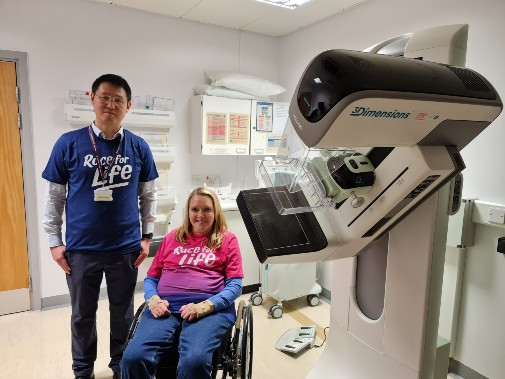Researchers Aim to Enhance Breast Screening for Patients with Limited Mobility Through Assistance Robots
The work, funded by Cancer Research UK, involves developing a prototype robot to gather data, with the aim of creating a commercially viable breast screening assistance system for use in clinical settings anywhere in the world.
Dr Jihong Zhu, a robotics expert from the University of York’s Institute for Safe Autonomy, was approached by radiologists from York Hospital who were looking for ways to improve accessibility after facing challenges at a routine mammogram with a patient who couldn’t access the machine.
Jane’s story
Jane Hudson, from Harrogate, was paralysed from the chest down following a cycling accident at the age of 32, and was unable to get into the right position for the screening machine, which meant that radiographers could not get any accurate images.
A few months later Jane was diagnosed with stage 3 breast cancer which had spread to her lymph nodes.
Following on from Jane’s experience, Dr Roisin Bradley, Consultant Radiologist at York and Scarborough NHS Trust, and Director of Breast Screening for North Yorkshire, met with Dr Zhu and realised that robotics could be the way forward.
Finding solutions
Dr Zhu, from the University of York’s Institute for Safe Autonomy and the School of Physics, Engineering and Technology, said: “I have previously developed assistive dressing robots for use in social care, and this experience has led me to believe that it can be useful in other healthcare settings.
“I was very moved by Jane’s experience, and understood how important it was to her to use this experience to create positive change. Knowing the challenges Jane faced, and by working with Dr Bradley, it was clear that we needed to employ a robotics system that consists of two collaborative robots that work to hold the weight of an individual and rotate them into the necessary position.
“Using force torque sensors – an electronic device that is designed to monitor, detect, record and regulate certain forces exerted upon it, and two infrared thermal cameras we can track posture during screening. This will be used as feedback to the robot to provide the right support and movement for a correct position.”
Breast screening uses a test called mammography which involves taking x-rays of the breasts. Screening can help to find breast cancers early when they are too small to see or feel.
Reducing deaths
The current evidence suggests that breast screening reduces the number of deaths from breast cancer by about 1,300 a year in the UK.
Jane Hudson said: “As well as being unable to walk I have no upper body strength at all, so I wasn’t able to get into the right position, even in my wheelchair. We tried all different positions, but it just wasn’t feasible and the radiographers were unable to get any accurate images.
“It was staggering to me that such a vital service was so inaccessible. I unintentionally became an advocate for raising awareness of the problem and looking for a solution with the help of my MP and the Spinal Injury Association.
“This new project has the potential to change the future of screening and offers a lot of hope for people with paralysis like mine. I am delighted to be part of the project to help develop the robot.”
Accessible to all
Following her diagnosis, Jane had a mastectomy, but due to a weakened immune system as a result of her spinal injury, she had to decide against having chemotherapy due to the risk it posed to her.
Dr Roisin Bradley, who is based at the Magnolia Centre at York Hospital, said: “I met Dr Zhu at a research meeting in 2023, designed to bring clinicians and researchers together, and after seeing the work he was doing I asked if he might have a solution for our problem.
“That was the start of the working group, and thanks to Cancer Research UK funding, we can make the first step toward ensuring mammograms are accessible to everyone.”

